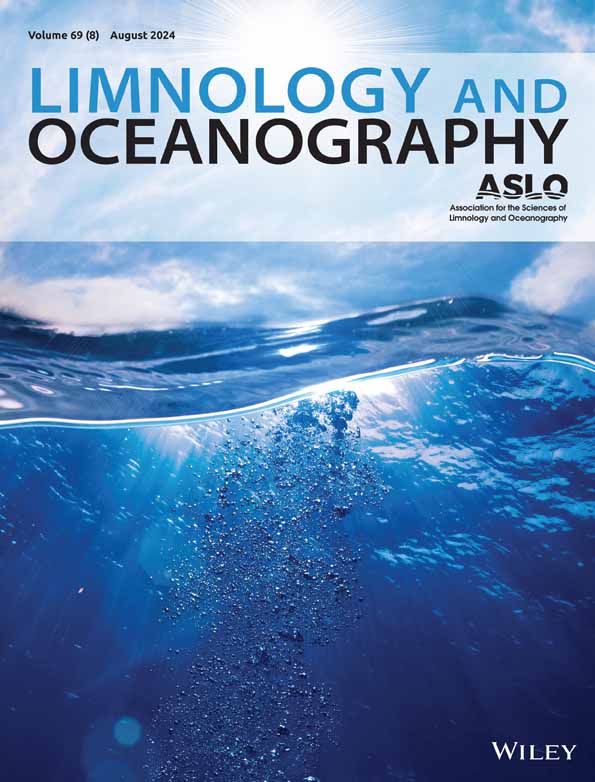Dynamic benthic oxygen fluxes lessen hypoxia effects on open continental shelves
IF 3.7
1区 地球科学
Q1 LIMNOLOGY
引用次数: 0
Abstract
Under the supposition that organisms inhabiting physically dynamic marine environments are better able to survive hypoxic conditions than those experiencing little turbulent or advective augmentation of oxygen fluxes, we evaluated summertime benthic macrofauna communities, in situ aquatic eddy covariance measurements, and ex situ sediment core incubations from 5 latitudinally distinct mid‐shelf locations off Oregon–Washington, USA. Despite bottom water dissolved oxygen (DO) concentrations averaging from 17 to 75动态底栖动物氧通量减轻了开放大陆架上缺氧的影响
假设生活在物理动态海洋环境中的生物比那些经历少量湍流或平流氧通量增加的生物更能在缺氧条件下生存,我们评估了夏季底栖大型动物群落,原位水生涡旋相关方差测量和美国俄勒冈-华盛顿5个纬度不同的中陆架位置的非原位沉积物核心培养。尽管底水溶解氧(DO)平均浓度为17 ~ 75 μmol L−1,但每0.1 m2箱芯的无脊椎动物区系中含有11 ~ 28个类群,并且在速度变化较大的地点丰富度和丰度增加。18 ~ 30小时的涡旋相关速度记录有规律地显示了内波的到达。氧通量以15分钟为间隔,与由速度分量评估的多个流动参数相关。经测定,沉积物的日平均氧通量为- 3.5至- 23 mmol m - 2 d - 1,假定这些通量完全代表海底呼吸作用,比来自相同地点的沉积物岩心吸收DO的速率大2至5倍。在海底上方0.3至2.5 m处测量的速度剖面与受海洋膨胀调制的波流边界层相一致。这些发现说明了自然物理过程如何缓解底栖动物缺氧暴露的压力。物理动力学在提供DO和决定沉积物粒度、渗透性和底栖生物活动方面起着关键作用。因此,在预测沿海地区低DO浓度的影响时,需要考虑这些因素。
本文章由计算机程序翻译,如有差异,请以英文原文为准。
求助全文
约1分钟内获得全文
求助全文
来源期刊

Limnology and Oceanography
地学-海洋学
CiteScore
8.80
自引率
6.70%
发文量
254
审稿时长
3 months
期刊介绍:
Limnology and Oceanography (L&O; print ISSN 0024-3590, online ISSN 1939-5590) publishes original articles, including scholarly reviews, about all aspects of limnology and oceanography. The journal''s unifying theme is the understanding of aquatic systems. Submissions are judged on the originality of their data, interpretations, and ideas, and on the degree to which they can be generalized beyond the particular aquatic system examined. Laboratory and modeling studies must demonstrate relevance to field environments; typically this means that they are bolstered by substantial "real-world" data. Few purely theoretical or purely empirical papers are accepted for review.
 求助内容:
求助内容: 应助结果提醒方式:
应助结果提醒方式:


